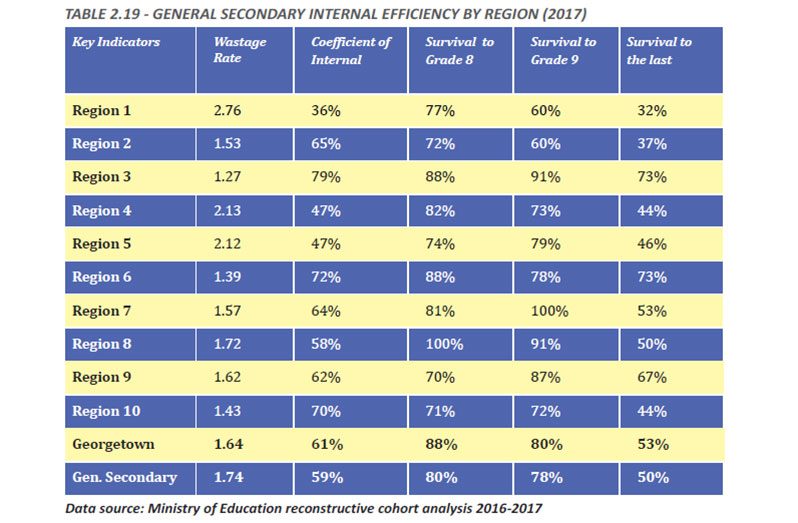— help for school leavers in Five-Year Strategic Plan
ONLY 50 per cent of students who are enrolled in secondary schools remain until the final grade, with five regions falling below this national average.
This is according to statistics from 2017 which are documented in the Ministry of Education’s recently launched Education Sector Plan (ESP) 2021 – 2025, where high focus is being placed on addressing school leavers.
Region One (Barima-Waini) and Region Two (Pomeroom-Supenaam) have the lowest rates of students who remain and this situation affects male students disproportionately more than females.
“The general secondary level is inefficient in producing graduates, in any given period. Only half (50%) of a given cohort enrolled at the general secondary education level survives to the final grade. Only 39% of the male cohort who enrolled in general secondary survives to the final grade and 62% of female cohort enrolled at the beginning of general secondary survives to the final grade,” the report noted.
In Region One, this percentage drops to only 32 per cent of students in a cohort making it to the final grade level. In Region Two it is at 37 per cent, while both Regions Four and Ten are at 44 percent.
Regions Three and Six share the highest percentage of retention at 73 per cent each. Region Nine follows with 67 percent while Region Seven and Georgetown, which is a separate education district from Region Four, both have 53 per cent. Region Eight has 50 per cent while Region Five has 46 per cent.
The number of pupils making it to Grade Six at the primary level is more encouraging as the national average stands at 93 per cent. Four education districts – Regions Six, Nine, 10 and Georgetown – have a 100 per cent rate. The lowest rate for the primary level is the 79 per cent registered in Region Five.
These education statistics have far-reaching repercussions for the country’s economy. According to the Bureau of Standards, more than 50 per cent of Guyana’s working age population has a primary school education level or less.
Less than 1 percent has a masters or post graduate degree level education. Cognisant of the pivotal role that education plays in changing the landscape of Guyana’s labour force, the ESP 2021 – 2025 places high emphasis on the implementation of programmes and projects that will address school leavers.
“The advent of oil and other emerging sectors will change Guyana’s economic trajectory
within two years. The education sector, as the most critical driver of economic and social development, must be ready to provide students with the competencies and skills needed to enable them to pursue tertiary education and the world of work, the report notes.
The ESP strategic plan sets a five-year goal of achieving a national average of at least 65 percent of secondary school students reaching the final grade and 100 percent of primary school pupils making it to Grade Six.
The plan will seek to target school leavers particularly with technical and vocational education and training (TVET). The implementation of activities that ensure that every secondary school leaver obtains a Caribbean Vocational Qualification (CVQ) certificate, is among the ministry’s plan of action.
To get those in schools to stay in school, the plan is to increase school attendance at primary and secondary levels, through the implementation of welfare support programmes, which include the recently implemented public school cash grants as well as truancy campaigns, and sensitisation sessions.
The plan also aims to reinstate child-friendly protocols in schools with a goal of 90 per cent of schools being child-friendly by 2025 as well as to institute school readiness programmes, focused on learning and development for the child, through the use of screening protocols, programmes targeting parental attitude and involvement.
Additionally, the plan calls for an increase in the monitoring and management of mental health disorders in schools with at least 80 per cent of reported mental health cases being addressed by 2025.
Increasing the amount of trained teachers in the school system is also an initiative that will help to keep learners in schools.




.png)









